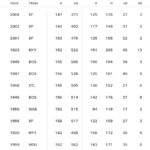In baseball, stats are a great indicator as to why teams are doing well or poorly in the standings and their odds of making the playoffs.
While most people look at the individual player stats, these values will not paint the full picture of the team.
I’m talking here about home runs, RBIs, strikeouts, ERA and so on.
While they are great for the individual, you must look at the team as a whole.
For example, the difference between runs scored versus runs given up on the season has a direct impact on the team’s win-loss record.
One more obscure stat is the team’s LOB value. When the average is high, the team is seeing success.
On the other hand, if the value is low, the team is unlikely to make the post-season.
So, without teasing it any further, let me explain what LOB stands for…
What does LOB mean in Baseball?
LOB is an acronym for “left on base” in baseball. It refers to the stat for baserunners left stranded on base at the end of an inning or game. The LOB stat is an indicator of the lost scoring opportunity by the batting team and measure of their overall offensive performance.
By contrast, the stat can also be viewed from the fielding team’s perspective, and their ability to prevent runs being scoring against.
While LOB is usually displayed for as a team stat, you can break it down to the individual player such as the batter or pitcher.
When a batter has a high LOB count, this means they have trouble driving home their teammates and can easily be exploited by the opposing team.
For the pitcher, the count is entirely circumstantial. If they were able to close out the inning with the bases loaded, their LOB count would be high.
However, did they allow runs to be scored earlier in the inning?
Is it really in the pitcher’s benefit to allow so many runners on base in the first place?
A high count for hits and walks is not a great statistic on the part of the pitcher.
What is a Good Team LOB?
The range of team LOB in the league is between 12-17. Teams on the higher end of the spectrum tend to do better in the standings.
These high LOB teams essentially prevent more runs against and leave the opposing baserunners stranded by inning’s end.
So, the report is on how many opposing runners the team in question leaves on base. The values are a defensive statistic.
TeamRankings has kept track of the team LOBs dating back to 2007.
The range has shifted throughout the years, but here’s where they currently lie:
Team LOB Chart
| Rating | Team LOB Value |
|---|---|
| Good | 14.5 or higher |
| Average | 14-14.4 |
| Bad | 12-13.9 |
In 2022, the New York Mets finished with the best Team LOB at 15.47. This should come to no surprise as they have pitchers Max Scherzer and Justin Verlander at the helm.
Not to mention their star closer in Edwin Diaz.
All three pitchers are amongst the highest paid for their roles. Diaz being the highest paid closer in all the league.
What is LOB%?
LOB% is a stat representing the percentage of baserunners a pitcher strands on base during the season.
It is correlated to the number of hits, walks, runs allowed using the following formula:
LOB% = (H+BB+HBP-R)/(H+BB+HBP-(1.4*HR))
H – hits
BB – walks
HBP – hit by pitch
R – runs
HR – Home runs
1.4 Factor – average runs scored per home run
Based on Fan Graphs, the average pitcher LOB% usually falls within the 70-72% mark.
Take note that these LOB% numbers can vary from year-to-year.
But the following table gives you an understanding of how a pitcher is doing on the year.
LOB% Rating for Pitchers
| Rating | Pitcher LOB% |
|---|---|
| Excellent | 80 |
| Good | 78 |
| Above Average | 75 |
| Average | 72 |
| Below Average | 70 |
| Bad | 65 |
| Awful | 60 |
For example, in 2022, Julio Urías of the Los Angeles Dodgers finished with the best LOB Percentage at 86.6%.
This is excellent LOB% reflects the his other season stats including a 2.16 ERA and 17-7 record.
Final Thoughts
Let’s be honest – the “Left on Base” stat is not something that comes to mind for the average fan in the thick of a playoff race or in the World Series.
However, the LOB value is an analytic that management can use to evaluate their teams.
If they were to dig a little deeper, upper management can see who the chief culprits are for leaving runners stranded on base.
Of course, if it’s on defense, they can analyze which pitcher can close out innings under the duress of runners already on base.
In the end, management can either trade, demote or shift players in their lineup.
For example, you can move the most efficient batters in the rotation where it’s more likely they’d have runners already on base.
Meanwhile, if their starting pitcher has a low LOB, it might be time to call in a reliever to complete the inning.
Analytics has become a huge part of today’s game, and the “left on base” stat needs to be dealt with for the good of the team.
Preventing additional runs against while squeezing out more runs on offense can be the difference in the hunt for a World Series title.






